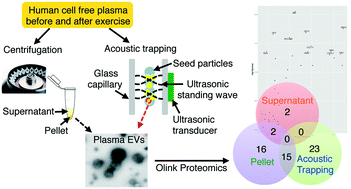Our official English website, www.x-mol.net, welcomes your
feedback! (Note: you will need to create a separate account there.)
Effect of exercise on the plasma vesicular proteome: a methodological study comparing acoustic trapping and centrifugation†
Lab on a Chip ( IF 6.1 ) Pub Date : 2018-08-24 00:00:00 , DOI: 10.1039/c8lc00686e Paulina Bryl-Górecka 1, 2, 3, 4, 5 , Ramasri Sathanoori 1, 2, 3, 4, 5 , Mariam Al-Mashat 2, 3, 4, 5, 6 , Björn Olde 1, 2, 3, 4, 5 , Jonas Jögi 2, 3, 4, 5, 6 , Mikael Evander 3, 4, 5, 7 , Thomas Laurell 3, 4, 5, 7 , David Erlinge 1, 2, 3, 4, 5
Lab on a Chip ( IF 6.1 ) Pub Date : 2018-08-24 00:00:00 , DOI: 10.1039/c8lc00686e Paulina Bryl-Górecka 1, 2, 3, 4, 5 , Ramasri Sathanoori 1, 2, 3, 4, 5 , Mariam Al-Mashat 2, 3, 4, 5, 6 , Björn Olde 1, 2, 3, 4, 5 , Jonas Jögi 2, 3, 4, 5, 6 , Mikael Evander 3, 4, 5, 7 , Thomas Laurell 3, 4, 5, 7 , David Erlinge 1, 2, 3, 4, 5
Affiliation

|
Extracellular vesicles (EVs) are a heterogeneous group of actively released vesicles originating from a wide range of cell types. Characterization of these EVs and their proteomes in the human plasma provides a novel approach in clinical diagnostics, as they reflect physiological and pathological states. However, EV isolation is technically challenging with the current methods having several disadvantages, requiring large sample volumes, and resulting in loss of sample and EV integrity. Here, we use an alternative, non-contact method based on a microscale acoustic standing wave technology. Improved coupling of the acoustic resonator increased the EV recovery from 30% in earlier reports to 80%, also displaying long term stability between experiment days. We report a pilot study, with 20 subjects who underwent physical exercise. Plasma samples were obtained before and 1 h after the workout. Acoustic trapping was compared to a standard high-speed centrifugation protocol, and the method was validated by flow cytometry (FCM). To monitor the device stability, the pooled frozen plasma from volunteers was used as an internal control. A key finding from the FCM analysis was a decrease in CD62E+ (E-selectin) EVs 1 h after exercise that was consistent for both methods. Furthermore, we report the first data that analyse differential EV protein expression before and after physical exercise. Olink-based proteomic analysis showed 54 significantly changed proteins in the EV fraction in response to physical exercise, whereas the EV-free plasma proteome only displayed four differentially regulated proteins, thus underlining an important role of these vesicles in cellular communication, and their potential as plasma derived biomarkers. We conclude that acoustic trapping offers a fast and efficient method comparable with high-speed centrifugation protocols. Further, it has the advantage of using smaller sample volumes (12.5 μL) and rapid contact-free separation with higher yield, and can thus pave the way for future clinical EV-based diagnostics.
中文翻译:

运动对血浆水泡蛋白质组的影响:比较声学捕获和离心的方法学研究†
细胞外囊泡(EVs)是主动释放的囊泡的异质性组,其起源于多种细胞类型。这些电动汽车及其蛋白质组在人血浆中的表征为临床诊断提供了一种新颖的方法,因为它们反映了生理和病理状态。但是,EV隔离在技术上具有挑战性,因为当前的方法有几个缺点,需要大量的样本,并且会导致样本丢失和EV完整性。在这里,我们使用基于微尺度声驻波技术的另一种非接触式方法。改进的声谐振器耦合将EV恢复率从早期报告的30%提高到80%,还显示了实验日之间的长期稳定性。我们报告了一项初步研究,其中有20名受试者进行了体育锻炼。在锻炼前和锻炼后1小时获取血浆样品。将声学捕获与标准高速离心协议进行了比较,并通过流式细胞仪(FCM)验证了该方法。为了监测设备的稳定性,将志愿者收集的冷冻血浆用作内部对照。来自FCM分析的一个关键发现是运动后1 h CD62E +(E-选择素)EV降低,这两种方法均一致。此外,我们报告了分析体育锻炼前后的差异EV蛋白表达的第一个数据。基于Olink的蛋白质组学分析表明,响应体育锻炼,EV组分中的54种蛋白质发生了显着变化,而不含EV的血浆蛋白质组仅显示了4种差异调节的蛋白质,因此强调了这些囊泡在细胞通讯中的重要作用,及其作为血浆生物标志物的潜力。我们得出的结论是,声学捕获提供了一种与高速离心协议相当的快速有效的方法。此外,它具有使用较小样品量(12.5μL)和快速无接触分离且产率更高的优点,因此可以为未来基于EV的临床诊断铺平道路。
更新日期:2018-08-24
中文翻译:

运动对血浆水泡蛋白质组的影响:比较声学捕获和离心的方法学研究†
细胞外囊泡(EVs)是主动释放的囊泡的异质性组,其起源于多种细胞类型。这些电动汽车及其蛋白质组在人血浆中的表征为临床诊断提供了一种新颖的方法,因为它们反映了生理和病理状态。但是,EV隔离在技术上具有挑战性,因为当前的方法有几个缺点,需要大量的样本,并且会导致样本丢失和EV完整性。在这里,我们使用基于微尺度声驻波技术的另一种非接触式方法。改进的声谐振器耦合将EV恢复率从早期报告的30%提高到80%,还显示了实验日之间的长期稳定性。我们报告了一项初步研究,其中有20名受试者进行了体育锻炼。在锻炼前和锻炼后1小时获取血浆样品。将声学捕获与标准高速离心协议进行了比较,并通过流式细胞仪(FCM)验证了该方法。为了监测设备的稳定性,将志愿者收集的冷冻血浆用作内部对照。来自FCM分析的一个关键发现是运动后1 h CD62E +(E-选择素)EV降低,这两种方法均一致。此外,我们报告了分析体育锻炼前后的差异EV蛋白表达的第一个数据。基于Olink的蛋白质组学分析表明,响应体育锻炼,EV组分中的54种蛋白质发生了显着变化,而不含EV的血浆蛋白质组仅显示了4种差异调节的蛋白质,因此强调了这些囊泡在细胞通讯中的重要作用,及其作为血浆生物标志物的潜力。我们得出的结论是,声学捕获提供了一种与高速离心协议相当的快速有效的方法。此外,它具有使用较小样品量(12.5μL)和快速无接触分离且产率更高的优点,因此可以为未来基于EV的临床诊断铺平道路。











































 京公网安备 11010802027423号
京公网安备 11010802027423号